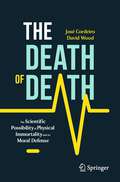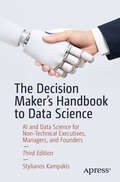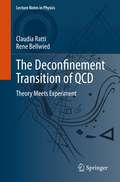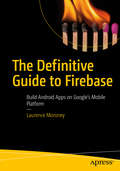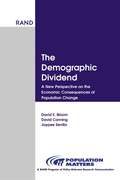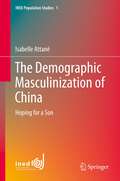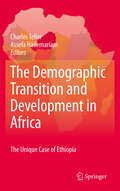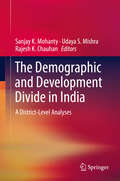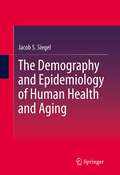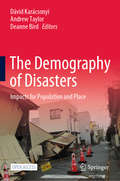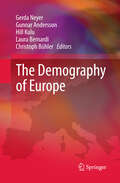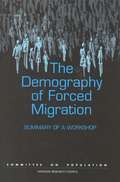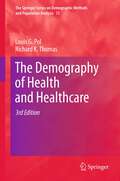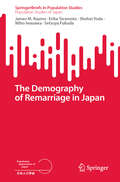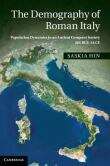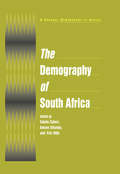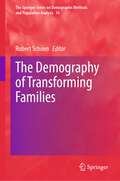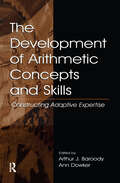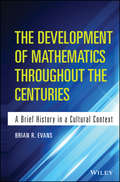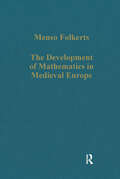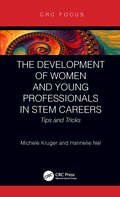- Table View
- List View
The Death of Death: The Scientific Possibility of Physical Immortality and its Moral Defense (Copernicus Books)
by David Wood José CordeiroIs death inevitable? Until now, the history of mankind has been marked by this fatal fact. Religions, borders and progress are born from an ancient fear of death, comfort from this fear man often found only in religious paradigms. But according to José Luis Cordeiro and David Wood, the incontrovertible fact of death is no longer an absolute certainty - science and technology are preparing to tear down the final frontier: that of immortality.This accessible book provides insight into recent exponential advances in artificial intelligence, tissue regeneration, stem cell treatment, organ printing, cryopreservation, and genetic therapies that, for the first time in human history, offer a realistic chance to solve the problem of the aging of the human body. In this book, Cordeiro and Wood not only present all the major developments, initiatives, and ideas for eternal life, they also show why there are a number of good arguments for seeing death for what it is: the last undefeated disease.Enter any drugstore or bookstore, and we confronted with a mountain of nonsense concerning the aging process. Society seems obsessed with aging. That is why The Death of Death is such a refreshing delight, able to cut through the hype and reveal a balanced, authoritative, and lucid discussion of this controversial topic. It summarizes the astonishing breakthroughs made recently in revealing how science may one day conquer the aging process.Michio Kaku, theoretical physicist and author of The God Equation: The Quest for a Theory of Everything We are entering a Fantastic Voyage into life extension, crossing different bridges that will take us to indefinite life spans. The Death of Death explains clearly how we might soon reach longevity escape velocity and live long enough to live forever. Ray Kurzweil, co-author of Fantastic Voyage: Live Long Enough to Live Forever and co-founder of Singularity University The Death of Death is a truly revolutionary book. This is a visionary book that confronts us with the terrible reality of aging, and its authors are friends and connoisseurs of the subject. I believe that the authoritative and exhaustive description of this crusade that José and David make in this excellent book will accelerate this process. Forward! Aubrey de Grey, founder of LEV (Longevity Escape Velocity) Foundation and co-author of Ending Aging
The Decision Maker's Handbook to Data Science: AI and Data Science for Non-Technical Executives, Managers, and Founders
by Stylianos KampakisData science is expanding across industries at a rapid pace, and the companies first to adopt best practices will gain a significant advantage. To reap the benefits, decision makers need to have a confident understanding of data science and its application in their organization. This third edition delves into the latest advancements in AI, particularly focusing on large language models (LLMs), with clear distinctions made between AI and traditional data science, including AI's ability to emulate human decision-making. Author Stylianos Kampakis introduces you to the critical aspect of ethics in AI, an area of growing importance and scrutiny. The narrative examines the ethical considerations intrinsic to the development and deployment of AI technologies, including bias, fairness, transparency, and accountability. You’ll be provided with the expertise and tools required to develop a solid data strategy that is continuously effective. Ethics and legal issues surrounding data collection and algorithmic bias are some common pitfalls that Kampakis helps you avoid, while guiding you on the path to build a thriving data science culture at your organization. This updated edition also includes plenty of case studies, tools for project assessment, and expanded content for hiring and managing data scientists. Data science is a language that everyone at a modern company should understand across departments. Friction in communication arises most often when management does not connect with what a data scientist is doing or how impactful data collection and storage can be for their organization. The Decision Maker’s Handbook to Data Science bridges this gap and readies you for both the present and future of your workplace in this engaging, comprehensive guide. What You Will Learn Integrate AI with other innovative technologies Explore anticipated ethical, regulatory, and technical landscapes that will shape the future of AI and data scienceDiscover how to hire and manage data scientistsBuild the right environment in order to make your organization data-driven Who This Book Is For Startup founders, product managers, higher level managers, and any other non-technical decision makers who are thinking to implement data science in their organization and hire data scientists. A secondary audience includes people looking for a soft introduction into the subject of data science.
The Deconfinement Transition of QCD: Theory Meets Experiment (Lecture Notes in Physics #981)
by Claudia Ratti Rene BellwiedIn the last few years, numerical simulations of QCD on the lattice have reached a new level of accuracy. A wide range of thermodynamic quantities is now available in the continuum limit and for physical quark masses. This allows a comparison with measurements from heavy ion collisions for the first time. Furthermore, calculations of dynamical quantities are also becoming available. The combined effort from first principles and experiment allows to gain an unprecedented understanding of the properties of quark-gluon plasma. This concise text, geared towards postgraduate students and newcomers to the field, carefully introduces and reviews the state-of-the-art techniques and results from lattice simulations and connects them to the experimental information from RHIC and the LHC.
The Definitive Guide to Firebase
by Laurence MoroneyPlan how to build a better app, grow it into a business, and earn money from your hard work using Firebase. In this book, Laurence Moroney, Staff Developer Advocate at Google, takes you through each of the 15 Firebase technologies, showing you how to use them with concrete examples. You'll see how to build cross-platform apps with the three pillars of the Firebase platform: technologies to help you develop apps with a real-time database, remote configuration, cloud messaging, and more; grow your apps with user sharing, search integration, analytics, and more; and earn from your apps with in-app advertising. After reading The Definitive Guide to Firebase, you'll come away empowered to make the most of this technology that helps you build better cross-platform mobile apps using either native Android or JavaScript-based web apps and effectively deploy them in a cloud environment. What You'll Learn Use the real-time database for a codeless middleware that gives online and offline data for syncing across your users' devices Master Firebase Cloud Messaging, a technology that delivers to connected devices in less than 500ms Grow your app organically with technologies such App Indexing, App Invites, and Dynamic Links Understand problems when they arise with crash reporting Fix user problems without direct access to users' devices Tie it all together with analytics that give you great intelligence about how users interact with your app Who This Book Is For Experienced Android, mobile app developers new to Firebase. This book is also for experienced web developers looking to build and deploy web apps for smartphones and tablets, too, who may be new or less experienced with mobile programming.
The Demographic Dividend
by Jaypee Sevilla David Canning David BloomThere is long-standing debate on how population growth affects national economies. A new report from Population Matters examines the history of this debate and synthesizes current research on the topic. The authors, led by Harvard economist David Bloom, conclude that population age structure, more than size or growth per se, affects economic development, and that reducing high fertility can create opportunities for economic growth if the right kinds of educational, health, and labor-market policies are in place. The report also examines specific regions of the world and how their differing policy environments have affected the relationship between population change and economic development.
The Demographic Masculinization of China: Hoping for a Son
by Isabelle AttanéThis book describes the shortage of girls and women in present day China and focuses on two important features: the sex imbalance in childhood and youth, and the excess mortality of women at various stages of their life. The author analyzes the causes and the processes of a strong preference for sons, which generates discrimination toward females and results in a shortage of girls and women. China's higher proportion of men than women is a population characteristic that is shared by very few countries in the world. This demographic masculinity is unprecedented in the documented history of human populations, both in scale and its lasting impact on the numbers and the structure of the population. Despite the economic boom of recent years, many families in China still consider girls to be less important than boys. Although Chinese women have become largely emancipated since the 1950s, they still do not have the same opportunities for social achievement as men, and Chinese society remains fundamentally rooted in highly gendered social and family roles. As a consequence, Chinese girl babies who have the misfortune to be born instead of a long-awaited son go by various names, such as Pandi (literally "awaiting a son"), Laidi ("a son will follow"), or Yehao ("she'll do too"). The book provides a comprehensive review of the situation of women in China's society and shows that discrimination against girls and women is part of a system of norms and values that traditionally favours males.
The Demographic Transition and Development in Africa
by Charles Teller Assefa Hailemariam"The heated Malthusian-Bosrupian debates still rage over consequences of high population growth, rapid urbanization, dense rural populations and young age structures in the face of drought, poverty, food insecurity, environmental degradation, climate change, instability and the global economic crisis. However, while facile generalizations about the lack of demographic change and lack of progress in meeting the MDGs in sub-Saharan Africa are commonplace, they are often misleading and belie the socio-cultural change that is occurring among a vanguard of more educated youth. Even within Ethiopia, the second largest country at the Crossroads of Africa and the Middle East, different narratives emerge from analysis of longitudinal, micro-level analysis as to how demographic change and responses are occurring, some more rapidly than others. The book compares Ethiopia with other Africa countries, and demonstrates the uniqueness of an African-type demographic transition: a combination of poverty-related negative factors (unemployment, disease, food insecurity) along with positive education, health and higher age-of-marriage trends that are pushing this ruggedly rural and land-locked population to accelerate the demographic transition and stay on track to meet most of the MDGs. This book takes great care with the challenges of inadequate data and weak analytical capacity to research this incipient transition, trying to unravel some of the complexities in this vulnerable Horn of Africa country: A slowly declining population growth rates with rapidly declining child mortality, very high chronic under-nutrition, already low urban fertility but still very high rural fertility; and high population-resource pressure along with rapidly growing small urban places"
The Demographic and Development Divide in India: A District-Level Analyses
by Sanjay K. Mohanty Udaya S. Mishra Rajesh K. ChauhanThis book is the first-ever volume which provides comprehensive information on demographic, health and development at the level of 640 districts in India. Central and state governments, developmental organizations, national and international NGOs and researchers require disaggregated data at the district level for many practical purposes. However, such information is not readily available for use. The editors, with a close-knit group of collaborators, have compiled data from reliable sources for each district of India and present the results in the form of composite indexes. The chapters rank districts within the state and vis-à-vis all districts of India to help readers understand intra-district and inter-district developmental disparities. They present spatial analyses that depict clustering of development. It is a ready reference for planners, researchers and students and provides scientific analyses that depict the clustering of development parameters at the district level. This volume is meant for a wide readership interested in development in India, across population studies, sociology, economics, statistics, to regional development, and from academics, researchers, and planners to policy makers.
The Demography and Epidemiology of Human Health and Aging
by Jacob S. SiegelWith this book, Siegel, an internationally known demographer and gerontologist, has made a unique contribution to the fledgling fields of health demography, and the demography and epidemiology of aging. The book represents a felicitous union of epidemiology, gerontology, and demography, and appears to be the first and only comprehensive text on this subject now available. Drawing on a wide range of sciences in addition to demography, gerontology, and epidemiology, including medical sociology, biostatistics, public policy, bioethics, and molecular biology, the author treats theoretical and applied issues, links methods and findings, covers the material internationally, nationally, and locally, and while focusing on the elderly, treats the entire life course. The methods, materials, and pespectives of demography and epidemiology are brought to bear on such topics as the prospects for future increases in human longevity, the relative contribution of life style, environment, genetics, and chance in human longevity, the measurement of the share of healthy years in total life expectancy, the role of population growth in the rising costs of health care, and the applications of health demography in serving the health needs of local communities. The separate chapters systematically develop the topics of the sources and quality of health data; mortality, life tables, and the measurement of health status; the interrelationships of health, on the one hand, and mortality, fertility, migration, and age structure, on the other; health conditions in the less developed countries; the concepts and theories of aging and projections of the aged population; and local health applications, public health policy, and bioethical issues in health demography. Given its comprehensiveness, clarity, interdisciplinary scope, and authencity, this book appeals to a wide range of users, from students and teachers of medical sociology, the demography of aging, and public health studies to practitioners in these areas, both as a text in health demography and the demography/epidemiology of aging, and as a reference work in these fields.
The Demography of Disasters: Impacts for Population and Place
by Andrew Taylor Dávid Karácsonyi Deanne BirdThis open access book provides worldwide examples demonstrating the importance of the interplay between demography and disasters in regions and spatially. It marks an advance in practical and theoretical insights for understanding the role of demography in planning for and mitigating impacts from disasters in developed nations. Both slow onset (like the of loss polar ice from climate change) and sudden disasters (such as cyclones and man-made disasters) have the capacity to fundamentally change the profiles of populations at local and regional levels. Impacts vary according to the type, rapidity and magnitude of the disaster, but also according to the pre-existing population profile and its relationships to the economy and society. In all cases, the key to understanding impacts and avoiding them in the future is to understand the relationships between disasters and population change. In most chapters in this book we compare and contrast studies from at least two cases and summarize their practical and theoretical lessons.
The Demography of Europe
by Gunnar Andersson Gerda Neyer Laura Bernardi Christoph Bühler Hill KuluOver the past decades Europe has witnessed fundamental changes of its population dynamics and population structure. Fertility has fallen below replacement level in almost all European countries, while childbearing behavior and family formation have become more diverse. Life expectancy has increased in Western Europe for both females and males, but has been declining for men in some Eastern European countries. Immigration from non-European countries has increased substantially, as has mobility within Europe. These changes pose major challenges to population studies, as conventional theoretical assumptions regarding demographic behavior and demographic development seem unfit to provide convincing explanations of the recent demographic changes. This book, derived from the symposium on "The Demography of Europe" held at the Max Planck Institute for Demographic Research in Rostock, Germany in November 2007 in honor of Professor Jan M. Hoem, brings together leading population researchers in the area of fertility, family, migration, life-expectancy, and mortality. The contributions present key issues of the new demography of Europe and discuss key research advances to understand the continent's demographic development at the turn of the 21st century.
The Demography of Forced Migration: Summary of a Workshop
by Committee on PopulationInformation on The Demography of Forced Migration
The Demography of Health and Healthcare
by Richard K. Thomas Louis G. PolIn this 3rd edition of the definitive work on health demography, Pol and Thomas offer an updated view of the field and a current perspective on the applications of health demography to contemporary issues. The significance of health demography within the field of population studies has continued to increase and this work provides background on the healthcare arena and systematically presents the various aspects of demography as they relate to healthcare. This addition has been streamlined to focus on the important aspects of health demography and enhanced through the addition of charts, maps and other graphics. All statistics and tables have been updated and the most current references are included. A separate chapter on morbidity has been included and the final chapter focuses on the public policy interface with health demography. Case studies and sidebars are included throughout the book to illustrate the applications of demography within the healthcare arena. Recent developments in U.S. healthcare are highlighted to give the text a very contemporary presence.
The Demography of Remarriage in Japan (SpringerBriefs in Population Studies)
by James M. Raymo Miho Iwasawa Erika Teramoto Shohei Yoda Setsuya FukudaThis book provides the first comprehensive demographic overview of remarriage in Japan. Despite the fact that nearly one in five marriages in Japan now involves at least one formerly married spouse, very little is known about the nature of remarriages and how they differ from first marriages. One important focus of this book is to examine fertility intentions and outcomes in remarriages and to compare them with marriages in which both partners are in their first marriage. It is well known that low rates of first marriage contribute to Japan’s very low total fertility rate (TFR), but there is currently no theoretical or empirical basis for understanding how levels and patterns of remarriage are related to the TFR. To understand trends and patterns of remarriage in Japan, the book begins with an overview of the voluminous research literature on remarriage in the USA and other Western countries. This overview consists of a summary of trends and theoretical frameworks for understanding remarriage and is followed by a summary of existing research on correlates of remarriage and outcomes associated with higher-order marriages. Of particular importance is the attention paid to stepfamily fertility and the extent to which remarriage is associated with overall levels of fertility. An important contribution of this book is its presentation of basic descriptive information about levels and correlates of remarriage in Japan. These descriptive analyses are based on published data in the vital statistics reports and individual-level data from the National Fertility Surveys conducted by the National Institute of Population and Social Security Research and the National Survey of Households with Children conducted by the Japan Institute for Labour Policy and Training.
The Demography of Roman Italy
by Saskia HinThis book provides a fresh perspective on the population history of Italy during the late Republic. It employs a range of sources and a multidisciplinary approach to investigate demographic trends and the demographic behaviour of Roman citizens. Dr Hin shows how they adapted to changing economic, climatic and social conditions in a period of intense conquest. Her critical evaluation of the evidence on the demographic toll taken by warfare and rising societal complexity leads her to a revisionist 'middle count' scenario of population development in Italy. In tracing the population history of an ancient conquest society, she provides an accessible pathway into Roman demography which focuses on the three main demographic parameters - mortality, fertility and migration. She unites literary and epigraphic sources with demographic theory, archaeological surveys, climatic and skeletal evidence, models and comparative data. Tables, figures and maps enable readers to visualise the quantitative dynamics at work.
The Demography of South Africa (A\general Demography Of Africa Ser.)
by Tukufu Zuberi Amson Sibanda Eric O. UdjoThis groundbreaking study of South Africa provides a unique look at the interplay of demographic, social and economic processes in a society undergoing rapid change as a result of the collapse of apartheid. It uses data from the first post-apartheid census as the basis for analysis of fertility, mortality within the context of HIV/AIDS, migration, education, employment, and household structure. These census data are complemented by large-scale household surveys and data from a partial registration system to study the relationships among various demographic, economic, and social phenomena. For the first time the demographic consequences of both the longer-term impact of apartheid policies and the policies of the new South Africa are examined and compared. This comprehensive reference links the demographic behavior of South Africa's various population groups to social, economic, and political inequalities created by policies of separate and unequal development. Prepared under the auspices of the Population Studies Center at the University of Pennsylvania, it is an essential resource for all scholars and practitioners in the field.
The Demography of Transforming Families (The Springer Series on Demographic Methods and Population Analysis #56)
by Robert SchoenThis book provides an up-to-date survey on the nature, causes, and patterns of family change. The traditional nuclear family has been replaced by a multiplicity of other forms, as widespread cohabitation, high levels of divorce and union dissolution, rising childlessness, and far below replacement fertility have emerged to an extent never before seen. Theoretical perspectives on this “Second Demographic Transition” are presented, highlighting the dramatic changes in gender roles. New methodological strategies for assessing family dynamics are presented, from multistate models of marriage and divorce combined with fertility to improved techniques for combining census and survey data on the family to a new approach for disentangling age, period, and cohort effects. While the volume emphasizes Western nations, insightful case studies range from analyzing family complexity in cohorts of parents and children in the UK to the impact of interpartner violence on family formation, to the emergence of a “gender war” in South Korea. By providing new insights into where we are today and how we got here, the book will be of value to all those interested in the contemporary family."Delayed Fertility as a Driver of Fertility Decline?" available open access under a Creative Commons Attribution 4.0 International License via link.springer.com.
The Design Inference
by William A. DembskiThe design inference uncovers intelligent causes by isolating their key trademark: specified events of small probability. Just about anything that happens is highly improbable, but when a highly improbable event is also specified (i. e. conforms to an independently given pattern) undirected natural causes lose their explanatory power. Design inferences can be found in a range of scientific pursuits from forensic science to research into the origins of life to the search for extraterrestrial intelligence. This challenging and provocative book shows how incomplete undirected causes are for science and breathes new life into classical design arguments. It will be read with particular interest by philosophers of science and religion, other philosophers concerned with epistemology and logic, probability and complexity theorists, and statisticians.
The Design of Approximation Algorithms
by David P. Williamson David B. ShmoysDiscrete optimization problems are everywhere, from traditional operations research planning (scheduling, facility location and network design); to computer science databases; to advertising issues in viral marketing. Yet most such problems are NP-hard; unless P = NP, there are no efficient algorithms to find optimal solutions. This book shows how to design approximation algorithms: efficient algorithms that find provably near-optimal solutions. The book is organized around central algorithmic techniques for designing approximation algorithms, including greedy and local search algorithms, dynamic programming, linear and semidefinite programming, and randomization. Each chapter in the first section is devoted to a single algorithmic technique applied to several different problems, with more sophisticated treatment in the second section. The book also covers methods for proving that optimization problems are hard to approximate. Designed as a textbook for graduate-level algorithm courses, it will also serve as a reference for researchers interested in the heuristic solution of discrete optimization problems.
The Design of Approximation Algorithms
by David P. Williamson David B. ShmoysDiscrete optimization problems are everywhere, from traditional operations research planning (scheduling, facility location and network design); to computer science databases; to advertising issues in viral marketing. Yet most such problems are NP-hard; unless P = NP, there are no efficient algorithms to find optimal solutions. This book shows how to design approximation algorithms: efficient algorithms that find provably near-optimal solutions. The book is organized around central algorithmic techniques for designing approximation algorithms, including greedy and local search algorithms, dynamic programming, linear and semidefinite programming, and randomization. Each chapter in the first section is devoted to a single algorithmic technique applied to several different problems, with more sophisticated treatment in the second section. The book also covers methods for proving that optimization problems are hard to approximate. Designed as a textbook for graduate-level algorithm courses, it will also serve as a reference for researchers interested in the heuristic solution of discrete optimization problems.
The Development of Arithmetic Concepts and Skills: Constructive Adaptive Expertise (Studies in Mathematical Thinking and Learning Series)
by Ann Dowker Arthur J. BaroodyThis volume focuses on two related questions that are central to both the psychology of mathematical thinking and learning and to the improvement of mathematics education: What is the nature of arithmetic expertise? How can instruction best promote it? Contributors from a variety of specialities, including cognitive, developmental, educational, and neurological psychology; mathematics education; and special education offer theoretical perspectives and much needed empirical evidence about these issues. As reported in this volume, both theory and research indicate that the nature of arithmetic expertise and how to best promote it are far more complex than conventional wisdom and many scholars, past and present, have suggested. The results of psychological, educational, and clinical studies using a wide range of arithmetic tasks and populations (including "normally" and atypically developing children, non-injured and brain-injured adults, and savants) all point to the same conclusion: The heart of arithmetic fluency, in general, and the flexible and creative use of strategies, in particular, is what is termed "adaptive expertise" (meaningful or conceptually based knowledge). The construction of adaptive expertise in mathematics is, for the first time, examined across various arithmetic topics and age groups. This book will be an invaluable resource for researchers and graduate students interested in mathematical cognition and learning (including mathematics educators, developmental and educational psychologists, and neuropsychologists), educators (including teachers, curriculum supervisors, and school administrators), and others interested in improving arithmetic instruction (including officials in national and local education departments, the media, and parents).
The Development of Mathematics
by E. T. Bell"This important book . . . presents a broad account of the part played by mathematics in the evolution of civilization, describing clearly the main principles, methods, and theories of mathematics that have survived from about 4000 BC to 1940."- BooklistIn this time-honored study, one of the 20th century's foremost scholars and interpreters of the history and meaning of mathematics masterfully outlines the development of its leading ideas, and clearly explains the mathematics involved in each. According to the author, a professor of mathematics at the California Institute of Technology from 1926 until his death in 1960, it is "not a history of the traditional kind, but a narrative of the decisive epochs in the development of mathematics." It is a narrative filled with compelling insights of special interest to every mathematician, engineer, and scientist.Main trends in mathematics from approximately 4000 BC to the 20th century are presented through analyses of typical major episodes in each. The author first examines the evolution of mathematical ideas in the ancient civilizations of Egypt and Babylonia; later developments in India, Arabia, and Spain; and other achievements worldwide through the 16th century. Professor Bell then traces the beginnings of modern mathematics in the 17th century, and the emergence of the importance of extensions of number, mathematical structure, the generalization of arithmetic, and structural analysis. Compelling accounts of major breakthroughs in the 19th and 20th centuries follow, emphasizing rational arithmetic after Fermat, contributions from geometry, and topics as diverse as generalized variables, abstractions, differential equations, invariance, uncertainties, and probabilities. Throughout, Professor Bell subordinates details of mere antiquarian interest - involving concepts and ideas that did not succeed or bear fruit - in favor of the fullest possible exposition of those elements still alive in mathematics.
The Development of Mathematics Throughout the Centuries: A Brief History in a Cultural Context
by Brian EvansThroughout the book, readers take a journey throughout time and observe how people around the world have understood these patterns of quantity, structure, and dimension around them. The Development of Mathematics Throughout the Centuries: A Brief History in a Cultural Contex provides a brief overview of the history of mathematics in a very straightforward and understandable manner and also addresses major findings that influenced the development of mathematics as a coherent discipline. This book: Highlights the contributions made by various world cultures including African, Egyptian, Babylonian, Chinese, Indian, Islamic, and pre-Columbian American mathematics Features an approach that is not too rigorous and is ideal for a one-semester course of the history of mathematics. Includes a Resources and Recommended Reading section for further exploration and has been extensively classroom-tested
The Development of Mathematics in Medieval Europe: The Arabs, Euclid, Regiomontanus (Variorum Collected Studies)
by Menso FolkertsThe Development of Mathematics in Medieval Europe complements the previous collection of articles by Menso Folkerts, Essays on Early Medieval Mathematics, and deals with the development of mathematics in Europe from the 12th century to about 1500. In the 12th century European learning was greatly transformed by translations from Arabic into Latin. Such translations in the field of mathematics and their influence are here described and analysed, notably al-Khwarizmi's "Arithmetic" -- through which Europe became acquainted with the Hindu-Arabic numerals -- and Euclid's "Elements". Five articles are dedicated to Johannes Regiomontanus, perhaps the most original mathematician of the 15th century, and to his discoveries in trigonometry, algebra and other fields. The knowledge and application of Euclid's "Elements" in 13th- and 15th-century Italy are discussed in three studies, while the last article treats the development of algebra in South Germany around 1500, where much of the modern symbolism used in algebra was developed.
The Development of Women and Young Professionals in STEM Careers: Tips and Tricks (CRC Press Focus Shortform Book Program)
by Michele Kruger Hannelie NelThis book is fluent and systematic. The authors work through the fears and ambitions of young people new to STEM careers in the professional environment. Often, there is a lack of mentors, which leaves a young STEM practitioner exposed and doubting their own abilities. This book encourages young professionals and women in STEM careers to know that they are not alone and provides insight into their ability to deal with the stress of developing into a successful professional. Features Presents a method or vehicle to fast track young professionals and women in STEM Includes key issues that they should be aware of as they grow and develop in their education and field Describes how STEM career women are owners of their own path and provides an understanding of engineering and the business of consulting Conveys how young professionals and women in STEM can be aware of their own productivity and enjoy what they do and the career path they have selected This book is ideal for those new to the engineering, science, and consulting fields, including students in science and engineering education, administrators, libraries, those involved in leadership, organization behavior, human resources, STEM, and other areas as well.
